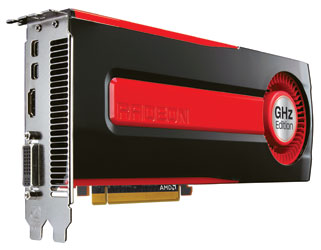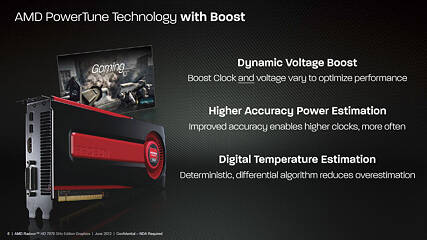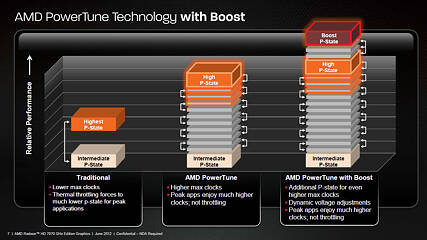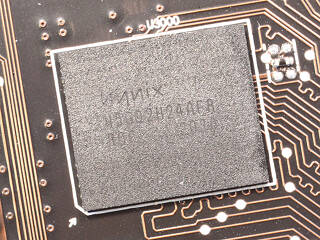 222
222
AMD Radeon HD 7970 GHz Edition 3 GB Review
(222 Comments) »Introduction

AMD launches its newest graphics processor, the Radeon HD 7970 GHz Edition, in a desperate bid to reclaim the single-GPU performance crown from NVIDIA. The move sparks a sense of déjà vu, taking us back to mid-2009, when AMD created the Radeon HD 4890 to compete against the then cheapened GeForce GTX 260 Core 216. While the HD 4890 used a new, redesigned ASIC, the new HD 7970 GHz Edition sticks to the same one as the HD 7970.
The Radeon HD 7970 GHz Edition ships with about 13.5% higher GPU and 9% higher memory clock speeds, it gets its "GHz Edition" brand extension from its ≥1 GHz GPU clock speed. Radeon HD 7870 and Radeon HD 7770 are the other GHz Edition SKUs from AMD. Increased clock speeds aren't the only things new about the HD 7970 GHz Edition; it is also the first high-end AMD GPU to feature PowerTune with Boost, a similar-sounding feature to NVIDIA GPU Boost.
The core of the HD 7970 GHz Edition is clocked as high as 1000 MHz, with a Boost frequency of 1050 MHz; while the memory is upped to 1500 MHz (actual) or 6.00 GHz (GDDR5 effective), resulting in a staggering 288 GB/s bandwidth thanks to the 384-bit wide memory interface. The PowerTune with Boost, on the other hand, is an evolution of AMD's PowerTune technology. Whereas PowerTune provides high maximum clock speeds, PowerTune with Boost uses a new deterministic algorithm that takes into account power-draw and temperatures, to find more opportunities to boost the clock speed. The technology even tunes the voltage, if it is required to support the Boost state, as long as power-draw and temperatures are within acceptable limits.

The card itself doesn't look any different from the reference design Radeon HD 7970, right down to its PCB layout, although we expect the SKU to be mostly sold as non-reference design graphics cards by AMD's contingent of add-in board partners. The move by AMD is to minimize development costs for itself, and its partners. AMD's one point agenda with the Radeon HD 7970 GHz Edition is retaking the performance crown from NVIDIA GeForce GTX 680. It is also priced on-par with it. In this review we will find out if AMD succeeds at it, and if so, at what 'cost'.
| GeForce GTX 580 | Radeon HD 7950 | GeForce GTX 670 | Radeon HD 7970 | HD 7970 GHz Edition | GeForce GTX 680 | Radeon HD 6990 | GeForce GTX 590 | GeForce GTX 690 | ||
|---|---|---|---|---|---|---|---|---|---|---|
| Shader Units | 512 | 1792 | 1344 | 2048 | 2048 | 1536 | 2x 1536 | 2x 512 | 2x 1536 | |
| ROPs | 48 | 32 | 32 | 32 | 32 | 32 | 2x 32 | 2x 48 | 2x 32 | |
| Graphics Processor | GF110 | Tahiti | GK104 | Tahiti | Tahiti | GK104 | 2x Cayman | 2x GF110 | 2x GK104 | |
| Transistors | 3000M | 4310M | 3500M | 4310M | 4310M | 3500M | 2x 2640M | 2x 3000M | 2x 3500M | |
| Memory Size | 1536 MB | 3072 MB | 2048 MB | 3072 MB | 3072 MB | 2048 MB | 2x 2048 MB | 2x 1536 MB | 2x 2048 MB | |
| Memory Bus Width | 384 bit | 384 bit | 256 bit | 384 bit | 384 bit | 256 bit | 2x 256 bit | 2x 384 bit | 2x 256 bit | |
| Core Clock | 772 MHz | 800 MHz | 915 MHz+ | 925 MHz | 1050 MHz | 1006 MHz+ | 830 MHz | 607 MHz | 915 MHz+ | |
| Memory Clock | 1002 MHz | 1250 MHz | 1502 MHz | 1375 MHz | 1500 MHz | 1502 MHz | 1250 MHz | 855 MHz | 1502 MHz | |
| Price | $380 | $380 | $400 | $450 | $500 | $500 | $700 | $750 | $999 |
Packaging & Contents
We received a card only from AMD, without packaging, but rest assured, the retail units will come with standard accessories like adapters and power cables.The Card
Visually the GHz Edition looks exactly the same as the normal HD 7970. The length of the card is 27.5 cm, which is the same as the HD 6970, for example.
The card requires two slots in your system.
Display connectivity options include one DVI port, one full size HDMI port and two mini-DisplayPorts. You may use all the outputs at the same time.
Please note that all the connectors are on the "first" slot now, which opens up the second one for a cooler grill through which hot air is blown out of the case. This also makes it possible to use the HD 7970 in a single slot configuration with a waterblock to cool the components.
An HDMI sound device is included in the GPU, too. It is HDMI 1.4a compatible which includes HD audio and support for Blu-ray 3D movies. The DisplayPort outputs are version 1.2 which enables the use of hubs and Multi-Stream transport.
You may combine up to four HD 7970 cards from any vendor in a multi-GPU CrossFire configuration for higher framerates or better image quality settings.
Pictured above are photos of the front and back, showing the disassembled board. High-res versions are also available (front, back). If you choose to use these images for voltmods etc., please include a link back to this site or let us post your article.
A Closer Look
AMD's fansink uses a large area vapor chamber cooler to keep the GPU cool. You can also see the thermal pads for twelve memory chips and the VRM circuitry.
The card requires one 8-pin and one 6-pin PCI-Express power cable for operation. This power configuration is good for up to 300 W of power draw.
The HD 7970 comes with AMD's dual BIOS feature that was introduced with the HD 6900 Series. It provides a safety net in case a BIOS flash goes wrong; simply switch to the second BIOS and flash back to the original BIOS.
For voltage control the card uses the CHiL CHL8228 chip, the same model found on the regular HD 7970, which means that software voltage control should be working with existing software.
The GDDR5 memory chips are made by Hynix, and carry the model number H5GQ2H24AFR-R0C. They are specified to run at 1500 MHz (6000 MHz GDDR5 effective).
AMD's Tahiti graphics processor introduced the GCN shader architecture, it is also the first GPU to be produced on a 28 nm process at TSMC. The transistor count is 4.31 billion.
Visually the GHz Edition GPU looks exactly the same as the regular Tahiti GPU. According to AMD both chips are made from the same wafers, with one receiving better binning.
Our Patreon Silver Supporters can read articles in single-page format.
Apr 25th, 2024 23:26 EDT
change timezone
Latest GPU Drivers
New Forum Posts
- Alphacool CORE 1 CPU block - bulging with danger of splitting? (17)
- What's your latest tech purchase? (20340)
- Black screen after muting (5)
- What phone you use as your daily driver? And, a discussion of them. (1481)
- What are you playing? (20530)
- Secure boot already open help (0)
- TPU's Nostalgic Hardware Club (18465)
- Post your Speedometer 3.0 Score (36)
- Size on Disk Excessively Different than Size (9)
- Dell Workstation Owners Club (3056)
Popular Reviews
- Fractal Design Terra Review
- Thermalright Phantom Spirit 120 EVO Review
- Corsair 2000D Airflow Review
- ASUS GeForce RTX 4090 STRIX OC Review
- NVIDIA GeForce RTX 4090 Founders Edition Review - Impressive Performance
- ASUS GeForce RTX 4090 Matrix Platinum Review - The RTX 4090 Ti
- MSI GeForce RTX 4090 Suprim X Review
- Gigabyte GeForce RTX 4090 Gaming OC Review
- MSI GeForce RTX 4090 Gaming X Trio Review
- MSI GeForce RTX 4090 Suprim Liquid X Review
Controversial News Posts
- Sony PlayStation 5 Pro Specifications Confirmed, Console Arrives Before Holidays (117)
- Windows 11 Now Officially Adware as Microsoft Embeds Ads in the Start Menu (110)
- NVIDIA Points Intel Raptor Lake CPU Users to Get Help from Intel Amid System Instability Issues (106)
- AMD "Strix Halo" Zen 5 Mobile Processor Pictured: Chiplet-based, Uses 256-bit LPDDR5X (101)
- US Government Wants Nuclear Plants to Offload AI Data Center Expansion (98)
- AMD's RDNA 4 GPUs Could Stick with 18 Gbps GDDR6 Memory (88)
- Developers of Outpost Infinity Siege Recommend Underclocking i9-13900K and i9-14900K for Stability on Machines with RTX 4090 (85)
- Windows 10 Security Updates to Cost $61 After 2025, $427 by 2028 (84)















